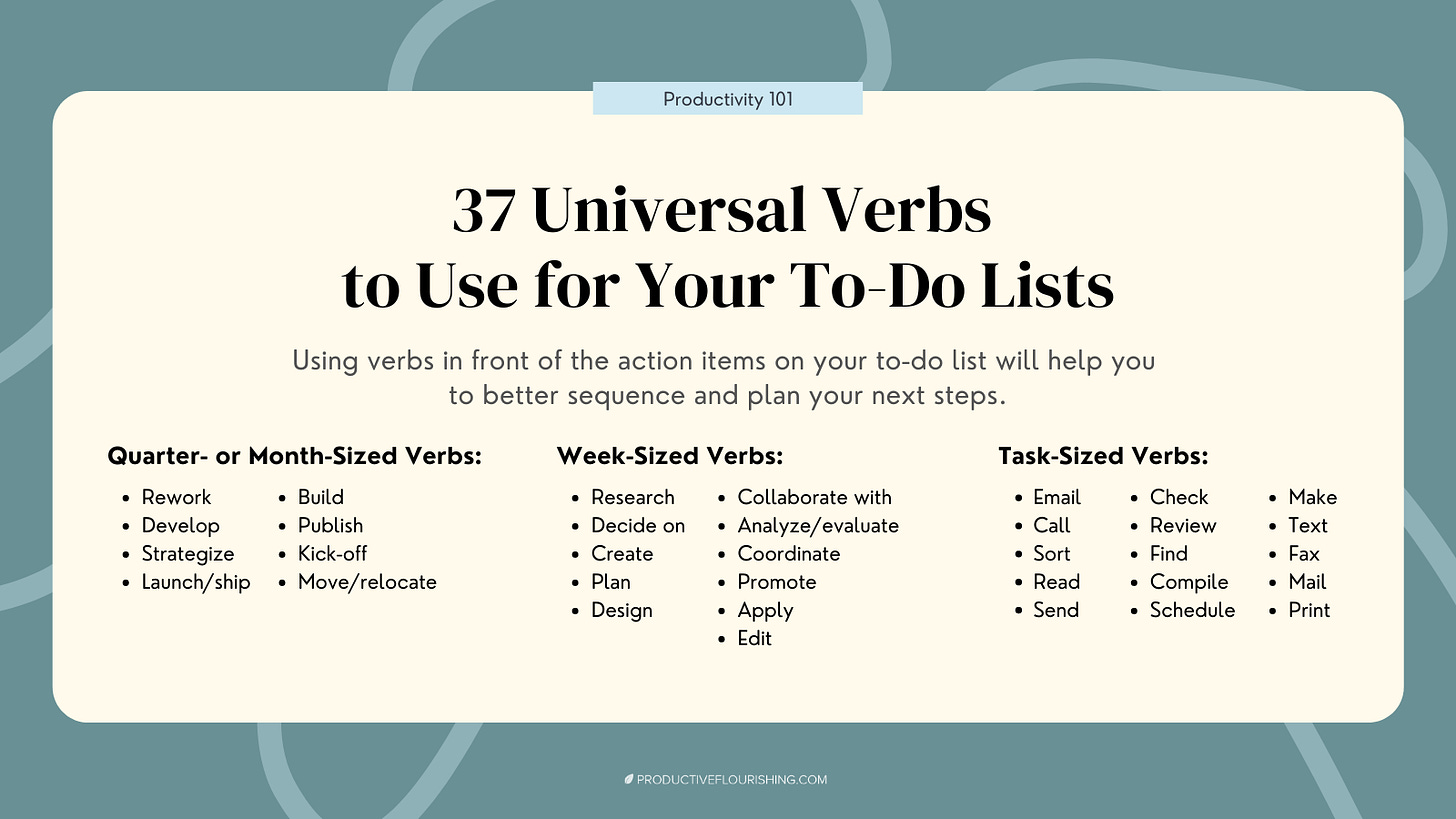37 Universal Verbs to Use for Your To-Do Lists
Verbs give us an idea of the size of the work, while nouns are constant throughout the project.
A common trip-up when people are making their to-do lists is that they’re either not using verbs in front of action items or the verbs aren’t working for them.
In an earlier post on writing effective to-do lists, I showed how using verbs helps us create momentum on our projects so we don’t spend time re-doing work (*blech*), looking over the same tasks (for the 100th *bleeping* time), or missing essential pieces of the project.
To make sure the verbs are doing more work for us, I shared more verbs in Chapter 4 of Start Finishing. These universal verbs are effective for different types of work, depending on what level of planning you’re looking at.
But more than just providing more verbs, the key insight is that the verbs themselves hint at what size of project you’re dealing with. Furthermore, these verbs create natural sequences. Thus, using these 37 verbs consistently helps you chunk, sequence, and plan your action steps.
Who knew verbs could do so much work?
The 37 Verbs, Broken Down By Time Horizon
Here are the 37 most important verbs to have on your task list to relate to the time horizon of your project:
Quarter- or month-sized verbs:
Rework
Develop
Strategize
Launch/ship
Build
Publish
Kick-off
Move/relocate
Week-sized verbs:
Research
Decide on
Collaborate with
Create
Plan
Design
Analyze/evaluate
Coordinate
Promote
Edit
Apply
Task-sized verbs:
Email
Call
Sort
Read
Send
Check
Review
Find
Compile
Schedule
Make
Text
Fax
Mail
Print
The Verbs in Context of a Project
It’s easier to see these verbs work in the context of a project.
Let’s say you’re wanting to reach a monthly goal of publishing 30 articles in 30 days. The verb you’d be using at the monthly level task list is “publish”. But you can’t publish something without creating and editing something first, and you usually can’t create something without planning and researching it before creating and editing. With this in mind, “research” and “plan” would be weekly-level task verbs you use to create your to-do list so that you can push your monthly goal of “publish” forward.
It might look something like this:
Monthly Project:
Publish 30 articles in 30 days
Weekly Projects:
Research other similar posts on the topics I wish to cover
Plan what content to write for each day
Daily tasks:
Review Blog post drafts
Schedule Blog post drafts
When we state the project chunks as verb-noun constructs, the verb is what gives us an idea of the size of the work and the noun is the constant throughout the project. Formulating your task list this way, you can easily piece together how your projects are linked, how much space a project might need depending on the number of chunks you pare it down to, and how to create the space for it in your planner.
And if you don’t get it all perfect at first, don’t worry, you’re not doing it wrong. Planning takes practice and patience. Try it with smaller projects, first, and work your way up from there.
If you’re ready to start sequencing and creating your plans from your chunked-down projects, look at how the verbs in front of the chunks relate to each other. Take the “Publish” project I mentioned before. Whether the sequence of working through this project becomes “Research > Plan > Create > Edit > Publish” or “Plan > Research > Create > Edit > Publish,” the outcome remains the same; at the end, I’ll have published articles, and I’ll have done the work that goes into creating them, checking each portion off my list as I go along.
How Will the Verbs Work for You?
An additional benefit of using these verbs is that scoping, sequencing, and planning projects starts to become automatic mental functions in the same way that you don’t have to work through figuring out what 4 x 5 is. Sure, some of us may need to think about what 6 x 7 is because it’s an unusual configuration of numbers, but the verbs become patterns similar to number bases of 1-5, 10, and so on.
I suggest trying these verbs out with two projects: an easy one that’s no bigger than a month-sized project and a larger one that’s a quarter-sized or larger. For most people, the latter is much more difficult AND getting good at pushing quarter-sized projects forward and linking them is a key unlock to doing your best work.
Remember, much like multiplication and division, chunking, sequencing, and planning are skills that we can all learn. Learning them takes some work in the beginning, but they do a lot of the work for you once you have them.
The most up-to-date version of the planner is inside the Momentum app -- try it now with a 30-day free trial. Or you can always download one of our free PDF planner pages here.






